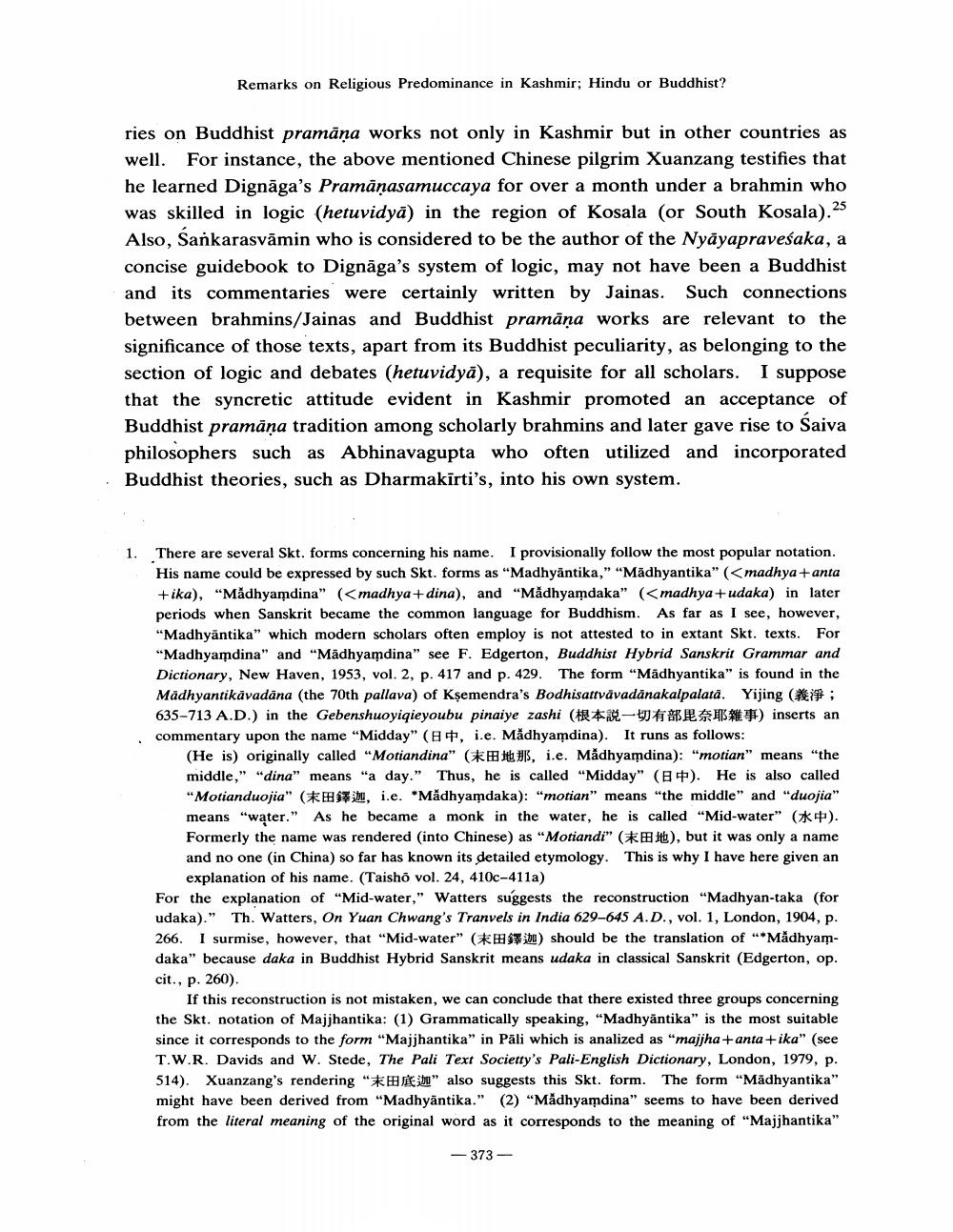Book Title: Remarks On Religious Predominance In Kashmir Hindu Or Buddhist Author(s): Toru Funayama Publisher: Toru Funayama View full book textPage 7
________________ Remarks on Religious Predominance in Kashmir; Hindu or Buddhist? ries on Buddhist pramāṇa works not only in Kashmir but in other countries as For instance, the above mentioned Chinese pilgrim Xuanzang testifies that he learned Dignaga's Pramäṇasamuccaya for over a month under a brahmin who was skilled in logic (hetuvidya) in the region of Kosala (or South Kosala).25 Also, Sankarasvamin who is considered to be the author of the Nyayapravesaka, a concise guidebook to Dignaga's system of logic, may not have been a Buddhist and its commentaries were certainly written by Jainas. Such connections between brahmins/Jainas and Buddhist pramāņa works are relevant to the significance of those texts, apart from its Buddhist peculiarity, as belonging to the section of logic and debates (hetuvidya), a requisite for all scholars. I suppose that the syncretic attitude evident in Kashmir promoted an acceptance of Buddhist pramāna tradition among scholarly brahmins and later gave rise to Saiva philosophers such as Abhinavagupta who often utilized and incorporated Buddhist theories, such as Dharmakirti's, into his own system. 1. There are several Skt. forms concerning his name. I provisionally follow the most popular notation. His name could be expressed by such Skt. forms as "Madhyantika," "Madhyantika" (<madhya+anta +ika), "Madhyamdina" (<madhya+dina), and "Madhyamdaka" (<madhya+udaka) in later periods when Sanskrit became the common language for Buddhism. As far as I see, however, "Madhyantika" which modern scholars often employ is not attested to in extant Skt. texts. For "Madhyamdina" and "Madhyamdina" see F. Edgerton, Buddhist Hybrid Sanskrit Grammar and Dictionary, New Haven, 1953, vol. 2, p. 417 and p. 429. The form "Madhyantika" is found in the Madhyantikāvadāna (the 70th pallava) of Kṣemendra's Bodhisattvävadānakalpalatā. Yijing (; 635-713 A.D.) in the Gebenshuoyiqieyoubu pinaiye zashi (R-VARESB) inserts an commentary upon the name "Midday" (H, i.e. Madhyamdina). It runs as follows: (He is) originally called "Motiandina" (, i.e. Madhyamdina): "motian" means "the middle," "dina" means "a day." Thus, he is called "Midday" (B). He is also called "Motianduojia" (, i.e. *Madhyamdaka): "motian" means "the middle" and "duojia" means "water." As he became a monk in the water, he is called "Mid-water" (*). Formerly the name was rendered (into Chinese) as "Motiandi" (t), but it was only a name and no one (in China) so far has known its detailed etymology. This is why I have here given an explanation of his name. (Taisho vol. 24, 410c-411a) For the explanation of "Mid-water," Watters suggests the reconstruction "Madhyan-taka (for udaka)." Th. Watters, On Yuan Chwang's Tranvels in India 629-645 A.D., vol. 1, London, 1904, p. 266. I surmise, however, that "Mid-water" (H) should be the translation of "*Madhyamdaka" because daka in Buddhist Hybrid Sanskrit means udaka in classical Sanskrit (Edgerton, op. cit., p. 260). If this reconstruction is not mistaken, we can conclude that there existed three groups concerning the Skt. notation of Majjhantika: (1) Grammatically speaking, "Madhyantika" is the most suitable since it corresponds to the form "Majjhantika" in Pāli which is analized as "majjha+anta+ika" (see T.W.R. Davids and W. Stede, The Pali Text Societty's Pali-English Dictionary, London, 1979, p. 514). Xuanzang's rendering "H" also suggests this Skt. form. The form "Madhyantika" might have been derived from "Madhyantika." (2) "Madhyamdina" seems to have been derived from the literal meaning of the original word as it corresponds to the meaning of "Majjhantika" -373Page Navigation
1 ... 5 6 7 8 9
